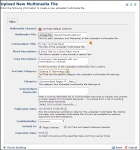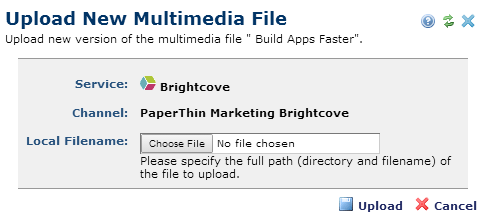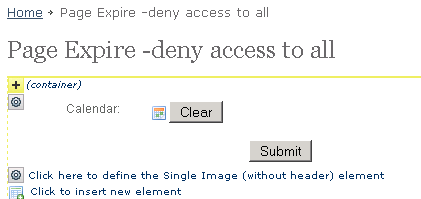
After you choose a channel and subsite location for your file, complete this form to assign standard metadata to multimedia files transferred from local or networked drives to dedicated multimedia servers.
Mouseover to view larger
This dialog is similar to the Create New Page, Upload New Document, or Upload New Image. You can upload any file type allowed by the external services used at your site, or any of the standard file types CommonSpot supports for local service. See Multimedia Players - Local Service in the Administrator's Reference.
To replace existing multimedia files, select Upload New Version from the More Actions dropdown in My Multimedia, multimedia search results, or multimedia reports. This version of the dialog displays.

 Note: CommonSpot does not overwrite existing files, but maintains multiple versions for version history and rollback. See Notes on Uploading, Importing, Updating, and Deleting Multimedia Files in the Administrator's Reference for details.
Note: CommonSpot does not overwrite existing files, but maintains multiple versions for version history and rollback. See Notes on Uploading, Importing, Updating, and Deleting Multimedia Files in the Administrator's Reference for details.
Multimedia Channel displays the service logo and name of the CommonSpot channel you selected for upload.
In the Multimedia File field, enter the disk location or networked path of the new file if you know it, or click the Browse button to locate the file. CommonSpot displays the file name and automatically uploads the new multimedia file to the server or service supporting the channel you selected.
CommonSpot Title: Text entered here is the name used within CommonSpot for this video. This name displays as the video or multimedia title on external sites and within the breadcrumb trail, Page Index Elements and in reports.
CommonSpot uses the title text to generate the multimedia file URL. Each page, uploaded document, or multimedia file within CommonSpot has a separate, distinct and addressable URL, for easy bookmarking and direct navigation. Spaces and other punctuation are converted to underscores when generating the full URL name. Administrators can optionally set a maximum length for this field, or require the name to be entered in only lowercase letters. Click the yellow down arrow to pre-fill the next field with the current field value.
Short Description: Text here appears in the browser’s caption bar.
Long Description: Provides a brief summary of multimedia content. This summary displays as the description on the external host site.
YouTube Category: (YouTube only) YouTube prompts for categories separately from CommonSpot. Pick from the dropdown to categorize your content on YouTube.
You can also assign a CommonSpot Category to your file, or, with subsite-level permissions for creating categories, click New to create a category for the new file. Administrators control permissions for the Category option.
CommonSpot Keywords: Optionally enter one or more keywords to categorize this content. These keywords are internal to CommonSpot and by default are not viewed by search engines. Enter a comma-delimited list or click to Select Keywords.
Publication Date: Pick a date to schedule release. You can set the current date or publish at a future date and time. Click the calendar  icon to open the Date/Time Selection Control.
icon to open the Date/Time Selection Control.

Confidentiality: If enabled for your site, displays a dropdown list of options for setting the confidentiality level of this file. Select the appropriate option. This is commonly used for corporate intranet publishing.
Include In: Controls whether to show/hide this file in Page Index or search results output. Uncheck to exclude from Page Indexes or results returned by Search Elements or full-text searches. Choices here do not affect page display for Choose, Choose Page, or Find operations. Channel security controls which files display to other contributors (see the Site Administrator's Reference).

Expiration: Sets when and whether this file expires. This field defaults to No action as shown below.

Expiration alerts users to the currency of a given item. Clicking the calendar displays expiration options for this content, as shown below. With the proper permissions, use the Date/Time Selection Control and select a date/time for either expiring content or receiving a prompt to check content freshness. You can specify both a date and time for expiring uploaded files, as well as the action to take.
(Administrator privileges for containing pages are controlled by default page-level security options for the designated site within the CommonSpot Administrator. See Content Security Permissions in the CommonSpot Administrator’s Reference.)
Choose an action to take at expiration, to proactively inform or redirect users when information is no longer current. The arrival of the expiration date triggers the preset action requested:
You can opt to not trigger an action when this page expires by choosing No Action.
Choosing Warn of expiration displays a text entry form for optionally customizing a message to contributors.
Setting Deny Access to General Public or Deny Access to All prevents site visitors and CommonSpot contributors, respectively, from accessing the file upon expiration. Deny Access to All maintains administrative access to the file, with the option of using the Calendar Control for resetting the expiration date, as shown below.

All other users see a message like the following:
Selecting Redirect to Another Page/URL displays the Redirect URL field for entering or choosing a URL to display to users when this file expires.
Enter a brief text Description.
Category: Select from the dropdown list. If you have Category creation permissions, you can create a new Category by clicking New and following the prompts to add a category. Note that YouTube prompts for category information separately from CommonSpot.
Keywords: Accept or remove any default keywords that may display. Optionally associate new terms (separated by commas) for defining the image and for use in creating Keyword Views and enhanced Search results. For details on using this feature, see Select Keywords and the Keyword field description for Create New Page.
A Next button indicates that custom metadata is required. Click to complete.
Click Save when you have completed the form. If you try to upload a new, unauthorized, or non-standard file format, a warning displays.
 Note: Site Administrators can place restrictions on locally stored files and YouTube and Brightcove have their own file size guidelines. Consult their policy statements for details. You may see a dialog asking if the new file is below your site’s limit. Clicking Save uploads the file only if it meets size requirements. Upload does not complete for files exceeding size limitations. For local file upload an error message similar to the following displays:
Note: Site Administrators can place restrictions on locally stored files and YouTube and Brightcove have their own file size guidelines. Consult their policy statements for details. You may see a dialog asking if the new file is below your site’s limit. Clicking Save uploads the file only if it meets size requirements. Upload does not complete for files exceeding size limitations. For local file upload an error message similar to the following displays:
cp-cffile UPLOAD failed (C:/web/cfusion/newsite/images/=
Related Links
You can download PDF versions of the Content Contributor's, Administrator's, and Elements Reference documents from the support section of paperthin.com (requires login).
For technical support: